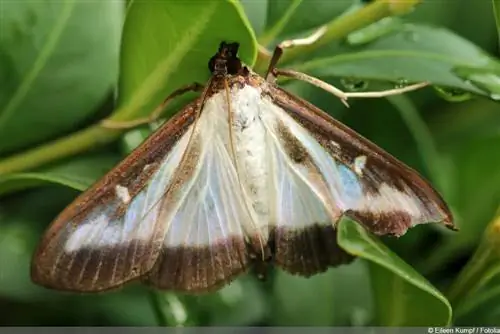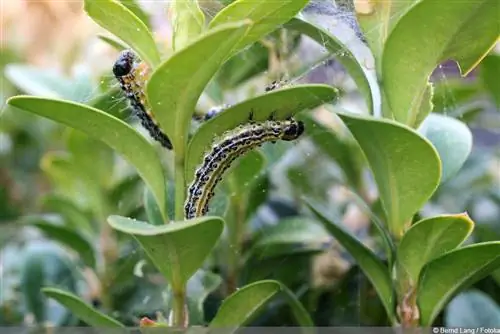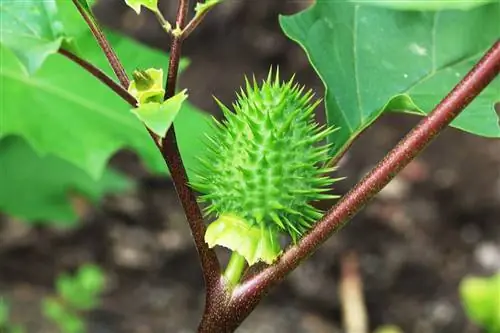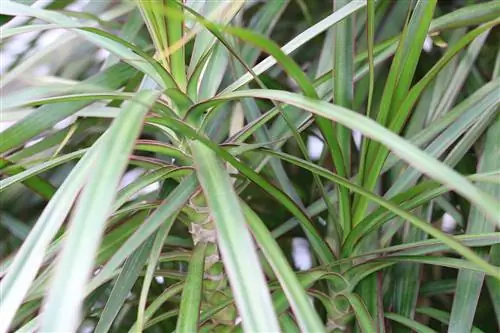- Author admin [email protected].
- Public 2023-12-17 03:39.
- Last modified 2025-01-24 12:45.
The boxwood borer has the botanical name Cydalima perspectalis and is a feared pest in these latitudes. The box trees in particular suffer from the voracious caterpillars, because this species can eat the trees completely bare and thereby destroy them. With regard to the reporting requirement and toxicity, certain measures must be taken to ensure that the infestation by this parasite does not get out of hand.
Detect infestation
The pest first comes to the boxwood as a moth, which can be easily seen with the naked eye. An adult butterfly can travel up to three kilometers between its last location and the current occurrence. Because of this, this pest can spread quickly over a large area. In addition, the butterfly can produce two to three generations per year, so the number of offspring adds up quickly. The caterpillars are particularly dangerous because they are extremely voracious and can occur in large numbers at once. Since the pests are usually hidden inside the trees and feed there, they are not so easy to track down. This is why an infestation with the box tree borer is often noticed very late.
- Butterfly has a white-black color, with the white part predominating
- There are brown edges on the wings, a black pattern on the inside
- Wingspan of up to 4.5 cm
- Is active from spring to late summer
- Lays up to 150 eggs on the underside of leaves
- Caterpillars are green, with black dots
- Height is up to 5 cm
- Leaves serve as a source of food for the young caterpillars
- Infestation usually begins on the lower branches
- Shown by eaten leaves
- Then the bark of the branches and younger twigs are eaten away
- Overwinteres in a cocoon
Tip:
If you have boxwood trees in your garden, you should check them regularly for infestation. Then the eggs and the young caterpillars can be fought in advance before they can cause major damage.
Toxicity & Symptoms

Small children in particular should be kept away from the caterpillars, as they touch everything out of curiosity and put it in their mouths. In addition to the parasites, the poisonous boxwood is always found in the same place; in combination, the two pose a serious he alth risk if contact occurs. Since the poison is absorbed through the skin, protective measures must be taken when combating and removing it. Some bird species have apparently developed a tolerance to the poison over time, so that they can feed on the caterpillars without any problems and even offer them as food to their offspring.
- Is generally poisonous
- But the pest does not produce the poison itself
- The poison of the boxwood is absorbed through food intake
- The poison is then stored to deter predators
- People are also affected by the poison, especially small children and older people
- Also avoid contact with animals
- Above all, keep away horses, dogs, cats and rabbits
- Symptoms include diarrhea, vomiting, cramps, paralysis, nausea and tremors
- In extreme cases, blood pressure can drop and even circulatory collapse occurs
- Always wear gloves when collecting the caterpillars
Reporting requirement
In Germany there is a statutory reporting requirement that concerns certain tree pests. This is to prevent epidemics and plagues from spreading. Some pests pose an enormous threat to the environment and require special control measures. As a rule, however, allotment gardeners are exempt from this obligation. If there has been a significant spread, it may still be advisable to report a possible occurrence. In this way, the responsible authorities can reduce the risk of an infestation in a timely manner. Pests must also be reported if they pose a major threat to the he alth of humans and animals. If it is a larger boxwood stand, an infestation by the pest should not be treated lightly.
- Reportable pest infestations are regulated according to Sections 16 and 17 of the Infection Protection Act
- Infestation with boxwood moth is not subject to the statutory reporting requirement
- Poisonings do not manifest themselves in a life-threatening manner
- If the infestation spreads excessively, it is better to report the infestation to the authorities
- The local he alth authorities of the cities and districts are responsible
- Quick intervention is required
- Especially for larger populations of box trees
- Pests can completely destroy trees
Tip:
If you are unsure about the pest, you should ask a tree expert for advice. This can identify the box tree borer in no time and at the same time suggest suitable control measures.






